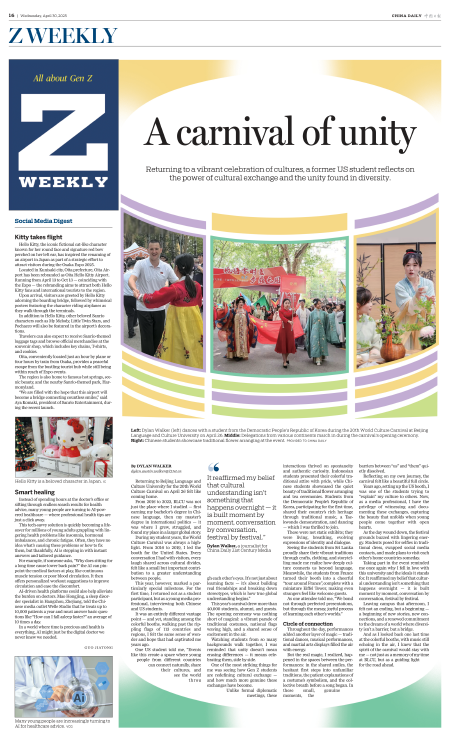

Hello Kitty is a beloved character in Japan.

Many young people are increasingly turning to AI for healthcare advice.
Kitty takes flight
Hello Kitty, the iconic fictional cat-like character known for her round face and signature red bow perched on her left ear, has inspired the renaming of an airport in Japan as part of a strategic effort to attract visitors during the Osaka Expo 2025.
Located in Kunisaki city, Oita prefecture, Oita Airport has been rebranded as Oita Hello Kitty Airport. Running from April 13 to Oct 13 — coinciding with the Expo — the rebranding aims to attract both Hello Kitty fans and international tourists to the region.
Upon arrival, visitors are greeted by Hello Kitty adorning the boarding bridge, followed by whimsical posters featuring the character riding airplanes as they walk through the terminals.
In addition to Hello Kitty, other beloved Sanrio characters such as My Melody, Little Twin Stars, and Pochacco will also be featured in the airport's decorations.
Travelers can also expect to receive Sanrio-themed luggage tags and browse official merchandise at the souvenir shop, which includes key chains, T-shirts, and cookies.
Oita, conveniently located just an hour by plane or four hours by train from Osaka, provides a peaceful escape from the bustling tourist hub while still being within reach of Expo events.
The region is also home to famous hot springs, scenic beauty, and the nearby Sanrio-themed park, Harmonyland.
"We are filled with the hope that this airport will become a bridge connecting countless smiles," said Aya Komaki, president of Sanrio Entertainment, during the recent launch.
Smart healing
Instead of spending hours at the doctor's office or sifting through endless search results for health advice, many young people are turning to AI-powered healthcare — where professional health tips are just a click away.
This tech-savvy solution is quickly becoming a lifesaver for millions of young adults grappling with lingering health problems like insomnia, hormonal imbalances, and chronic fatigue. Often, they have no idea what's causing these problems or how to fix them, but thankfully, AI is stepping in with instant answers and tailored guidance.
For example, if someone asks, "Why does sitting for a long time cause lower back pain?" the AI can pinpoint the medical factors at play, like continuous muscle tension or poor blood circulation. It then offers personalized workout suggestions to improve circulation and ease the discomfort.
AI-driven health platforms could also help alleviate the burden on doctors. Mao Hongjing, a sleep disorder specialist in Hangzhou, Zhejiang, told the Chinese media outlet Welle Studio that he treats up to 10,000 patients a year and must answer basic questions like "How can I fall asleep faster?" an average of 10 times a day.
In a world where time is precious and health is everything, AI might just be the digital doctor we never knew we needed.

